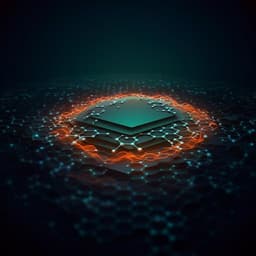
Engineering and Technology
Neuromorphic van der Waals crystals for substantial energy generation
S. Kim, S. Choi, et al.
Discover an innovative approach to energy harvesting in nanofluidics through the work of Sungsoon Kim, Sangjin Choi, Hae Gon Lee, Dana Jin, Gwangmook Kim, Taehoon Kim, Joon Sang Lee, and Wooyoung Shim. This research presents a neuro-inspired method leveraging confined van der Waals crystals to enhance ion diffusion flux, achieving remarkable ion selectivity and efficient power generation.
~3 min • Beginner • English
Introduction
The study addresses how to design nanofluidic channels that mimic biological ion channels to generate electromotive force via selective cation transport. Biological neuron channels achieve fast, energy-efficient signaling through pores with effective sizes of 4–5 Å, functional groups (e.g., carboxylates) that enhance cation selectivity and reduce dehydration barriers, and structural stability in aqueous environments. Existing artificial membranes struggle to meet all three requirements simultaneously. The purpose here is to create a neuromorphic, van der Waals (vdW) crystal-based channel—using graphene oxide (GO) physically confined with epoxy—that maintains an angstrom-scale effective channel height comparable to cation size, provides negative surface functional groups to enhance selectivity and dehydration, and remains structurally stable in liquid, thereby enabling practical, sustained energy generation from concentration gradients.
Literature Review
Prior work in nanofluidics and osmotic energy conversion includes 2D porous structures and 3D heterogeneous composites aimed at ion selectivity and stability (e.g., graphene oxide, MXene, MoS2 membranes). Strategies such as oxidative functionalization and composite membranes tuned surface charge density to increase ion selectivity. Robust channels using diode-like organic membranes and epoxy-confined structures improved longevity. Landmark studies showed ion sieving and osmotic power generation in nanopores and nanotubes, ultrathin Janus membranes, and MXene-based membranes. However, integrating pore-size control at the angstrom scale, high surface charge for selectivity and dehydration, and structural robustness for long-term operation in liquid remains challenging. The present work aims to satisfy all three concurrently, inspired by neuron channel physiology.
Methodology
- Materials and device fabrication: GO films were prepared by drop-casting a concentrated GO solution (5 g/L) onto substrates (slide glass or OHP film) and dried at 25 °C for 24 h to thicknesses of 5 µm or 20 µm. Ag/AgCl ink electrodes were applied to both ends and dried. A commercial epoxy (S-208) was applied at the center of the GO membrane to physically confine the interlayer spacing, forming the channel; dried 24 h.
- Cell configuration: The membrane is partitioned into epoxy-pasted (channel) and non-epoxy (reservoir) regions. Two reservoirs (I, II) were wetted with electrolytes at concentrations C1 and C2, respectively, establishing chemical potential gradients. Typical channel dimensions: width ≈ 1.5 cm, length ≈ 3 mm (varied up to 13 mm), height = 5 µm (also 20 µm tested).
- Structural characterization: XRD monitored interlayer spacing in reservoirs and channel during wetting. Reservoir regions swelled (low-angle shifts, peak broadening, eventual disappearance). Confined channel peaks shifted by 0.46°, corresponding to an interlayer spacing change of ~0.3 Å. Effective free spacing δ ≈ 4.5 Å (d minus GO layer thickness 3.4 Å). SEM-EDS mapped Na and Cl distributions across the cross-section during diffusion. Zeta potential measured vs pH. FTIR and XPS characterized functional groups.
- Electrical/ionic measurements: I–V curves measured under (i) equal concentrations (0.1 M) to obtain Ohmic conductance for different cations (Na+, K+, Ca2+) and channel lengths; and (ii) concentration gradients (e.g., 1 M vs 1 mM NaCl; also 100 mM/10 mM) to obtain open-circuit voltage (Voc) and short-circuit current (Isc). Contributions from electrode redox due to unequal Cl− activities were separated using Nernst-based modeling; diffusion current/voltage (Idiff, Vdiff) extracted by subtracting redox contribution (Iredox, Vredox). Ion selectivity calculated as ratio of measured to Nernst-predicted voltage. Power density and energy conversion efficiency computed from I–V characteristics (excluding/including redox contributions) per Supplementary calculations.
- Diffusion analysis: Fick’s first law used with EDS profiles (at t = 5 s) to estimate Na+ diffusion coefficient within the channel; Einstein relation used to infer mobility.
- pH dependence: Conductance, Voc, and Isc measured at 1 M NaCl over pH 2–10; correlated with zeta potential (surface deprotonation of carboxyl groups).
- MD simulations: GO channels with (i) COOH and (ii) fully deprotonated COO− surfaces modeled to compute free energy barriers for dehydration of K+, Na+, and Ca2+ entering the channel, and radial distribution functions indicating hydration shells.
- Humidity/dry-cell studies: Three states tested—(I) liquid dropped on reservoirs, (II) fully dried (RH < 20%), (III) rewetted by ambient humidity (RH > 60%). Voc monitored over time; capillary condensation analyzed via heterogeneous nucleation theory and Kelvin equation, estimating critical radius and Gibbs free energy including wetting factor.
- Practical demonstrations: Constant-current discharge at 2 µA for single cells with different channel dimensions (Cell I: w 1.5 cm, l 3 mm, h 5 µm; Cell II: w 4 cm, l 3 mm, h 20 µm) in sealed and humidity-cycled states. Series connections (3, 6, 16 cells) assembled using Ag/AgCl ink to increase Voc; powering single and multiple LEDs (including 19 red LEDs via Arduino). Flexible implementation on plastic substrates. Tests with real seawater (~0.5 M) and river water (~0.01 M) after filtration.
Key Findings
- Confined channel size: Effective free spacing δ ≈ 4.5 Å, comparable to biological ion channels (4–5 Å), achieved via epoxy confinement; robust against swelling in liquids.
- Ion transport selectivity and conductance: At 0.1 M, conductance scales with ion type and dehydration barrier: CaCl2 (4.8 µS) < KCl (20.1 µS) < NaCl (30 µS). Shorter channel length yields higher conductance.
- Concentration cell performance (1 M vs 1 mM NaCl): Measured Voc ≈ 0.32 V (sum of diffusion 0.16 V and electrode redox 0.16 V). Diffusion current Idiff ≈ 4.9 µA; Vdiff ≈ 0.16 V. Modeled Iredox ≈ 4.9 µA and Vredox ≈ 0.16 V.
- Ion selectivity and efficiency: Cation selectivity 95.8% (at 1 M/1 mM). Energy conversion efficiency ~41.4% at maximum power—reported as highest among osmotic systems surveyed. Power density from cation-selective diffusion ≈ 5.26 W/m² (excluding redox; including redox 10.56 W/m²). Selectivity remained >90% for 10^1 and 10^2 gradients.
- Stability: Voc ~0.32 V established within seconds and maintained for at least 18 h; when sealed to prevent drying, operation sustained up to 150 h even at 1 M NaCl. Non-epoxy GO loses voltage over time due to swelling.
- Diffusion and mobility: Na+ diffusion coefficient in channel 2.56–3.34 × 10^−9 m²/s (≈1.75–2.3× bulk 1.46 × 10^−9 m²/s). Mobility 8.5–13.56 × 10^−8 m²/V·s, consistent via Einstein relation.
- pH dependence: Conductance, Voc, and Isc increase with pH (2–10), correlating with more negative zeta potential (greater deprotonation). MD shows deprotonated COO− reduces dehydration barrier most strongly for Na+, nearly eliminating it.
- Partial dehydration: RDFs show reduced hydration shells inside GO channel; Na+ loses second hydration shell, aiding faster transport vs K+.
- Humidity-enabled operation: Fully dried cells (RH < 20%) cease output; at RH > 60%, capillary condensation within channels restores Voc ≈ 0.32 V. Long-term cycling over 20 h demonstrates transitions between dry and rewetted steady states.
- Practical demos: Constant-current discharge at 2 µA yields >4000 µAh/g; Cell II energy density ~1180 Wh/g. In unsealed then sealed humidity-cycled tests, Cell I delivers 1553 µAh/g at ~0.16–0.25 V. Series connections: 3 cells Voc ~0.89 V; 6 cells Voc ~1.9 V, Isc ~33.4 µA, lighting a red LED. Sixteen larger cells deliver Voc ~4.5 V, Is ~93 µA, power ~105.75 µW, lighting 19 parallel LEDs; flexible substrate implementation successful. Real seawater/river water gradient reproduces comparable Voc to artificial solutions.
Discussion
The work demonstrates that vdW-confined GO channels can emulate key neuron channel features—angstrom-scale pore size, negative functional groups for selectivity and reduced dehydration barrier, and structural robustness in liquids—to enable sustained unipolar cation diffusion and EMF generation. The high ion selectivity (≈96%) and substantial efficiency (≈41%) under high ionic strength (1 M) highlight the ability to maintain electric double layer overlap and controlled dehydration despite harsh conditions, overcoming swelling through epoxy confinement. Enhanced Na+ diffusion coefficients and mobilities confirm rapid transport consistent with partial dehydration facilitated by carboxylate groups, aligning with MD simulations. The device stability over tens to hundreds of hours and reactivation via capillary condensation at moderate RH expands usability beyond fully wet environments. Scaling via series/parallel packing achieves voltages and powers sufficient to run LEDs and suggests a pathway toward flexible, low-maintenance osmotic or humidity-driven power sources. These findings directly address the research aim of realizing neuromorphic energy harvesting through controlled ion transport in robust nanofluidic channels, bridging fundamental ion sieving with practical power generation.
Conclusion
The study introduces a neuromorphic energy-harvesting platform based on epoxy-confined GO vdW crystals that provide ~4.5 Å effective channels, high negative surface charge density, and long-term structural stability. The system achieves outstanding cation selectivity (95.8%), energy conversion efficiency (41.4%), and diffusion power density (5.26 W/m²) while maintaining output for up to 150 h and operating under ambient humidity via capillary condensation. Demonstrations of constant-current discharge, scalable series connections, flexible form factors, and operation with real seawater/river water illustrate practical potential. Future work should (i) quantitatively correlate cation dehydration energetics with tunable surface chemistries and charge densities, (ii) optimize and shorten channel lengths to reduce resistance and improve power, (iii) fabricate large-area parallel channel arrays for scaling, and (iv) address structural differences with biological pores to exploit alternative diffusion mechanisms for further performance gains.
Limitations
Despite neuromorphic features, the interlayer channels differ structurally from biological nanopores, potentially affecting diffusion mechanisms (e.g., knock-on vs interlayer transport). Operation relies on maintaining hydration within channels (via liquid or sufficient ambient humidity), and performance depends on electrode redox contributions when present, necessitating careful separation of diffusion-derived power. High functional group densities can increase activation energy for transport, limiting gains at very high pH. Further engineering is required for mass manufacturing of uniform, large-area, parallel channels and for minimizing internal resistance for higher absolute power outputs.
Related Publications
Explore these studies to deepen your understanding of the subject.







